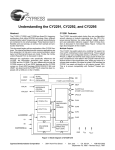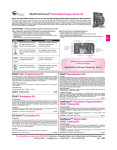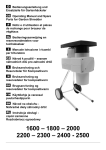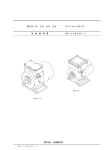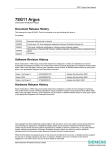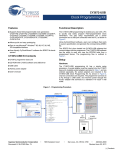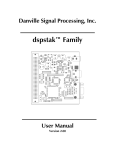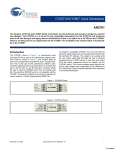Download Cypress CY2291 User's Manual
Transcript
CY2291 Three-PLL General Purpose EPROM Programmable Clock Generator Features Benefits ■ Three integrated phase-locked loops ■ ■ EPROM programmability Generates up to three custom frequencies from external sources ■ Factory-programmable (CY2291) or field-programmable (CY2291F) device options ■ Easy customization and fast turnaround ■ Programming support available for all opportunities ■ Low-skew, low-jitter, high-accuracy outputs ■ Meets critical industry standard timing requirements ■ Power-management options (Shutdown, OE, Suspend) ■ Supports low-power applications ■ Frequency select option ■ Eight user-selectable frequencies on CPU PLL ■ Smooth slewing on CPUCLK ■ Allows downstream PLLs to stay locked on CPUCLK output ■ Configurable 3.3V or 5V operation ■ Enables application compatibility ■ 20-pin SOIC Package ■ Industry-standard packaging saves on board space Part Number Outputs Input Frequency Range Output Frequency Range Specifics CY2291 8 10 MHz–25 MHz (external crystal) 1 MHz–30 MHz (reference clock) 76.923 kHz–100 MHz (5V) 76.923 kHz–80 MHz (3.3V) Factory Programmable Commercial Temperature CY2291I 8 10 MHz–25 MHz (external crystal) 1 MHz–30 MHz (reference clock) 76.923 kHz–90 MHz (5V) 76.923 kHz–66.6 MHz (3.3V) Factory Programmable Industrial Temperature CY2291F 8 10 MHz–25 MHz (external crystal) 1 MHz–30 MHz (reference clock) 76.923 kHz–90 MHz (5V) 76.923 kHz–66.6 MHz (3.3V) Field Programmable Commercial Temperature CY2291FI 8 10 MHz–25 MHz (external crystal) 1 MHz–30 MHz (reference clock) 76.923 kHz–80 MHz (5V) 76.923 kHz–60.0 MHz (3.3V) Field Programmable Industrial Temperature Logic Block Diagram 32XIN 32K OSC. 32XOUT XTALIN OSC. XTALOUT XBUF CPLL (8 BIT) /1,2,4 CPUCLK S0 CLKA S1 S2/SUSPEND SPLL (8 BIT) CLKB /1,2,4,8 MUX UPLL (10 BIT) /1,2,3,4,5,6 /8,10,12,13 /20,24,26,40 /48,52,96,104 CLKD /2,3,4 CLKF CONFIG EPROM SHUTDOWN/ OE Cypress Semiconductor Corporation Document #: 38-07189 Rev. *C CLKC • 198 Champion Court • San Jose, CA 95134-1709 • 408-943-2600 Revised September 16, 2008 [+] Feedback CY2291 Pinouts Figure 1. CY2291- 20-pin SOIC 32XOUT 1 20 32XIN 32K 2 19 CLKC 3 18 VBATT SHUTDOWN/OE VDD GND XTALIN 4 17 S2/SUSPEND 5 16 6 15 VDD S1 XTALOUT 7 14 S0 8 9 13 12 CLKF CLKA 10 11 CLKB XBUF CLKD CPUCLK Pin Definitions Name Pin Number Description 32XOUT 1 32.768-kHz crystal feedback. 32K 2 32.768-kHz output (always active if VBATT is present). CLKC 3 Configurable clock output C. VDD 4, 16 GND 5 Ground. XTALIN[1] 6 Reference crystal input or external reference clock input. XTALOUT[1, 2] 7 Reference crystal feedback. XBUF 8 Buffered reference clock output. CLKD 9 Configurable clock output D. CPUCLK 10 CPU frequency clock output. CLKB 11 Configurable clock output B. CLKA 12 Configurable clock output A. CLKF 13 Configurable clock output F. S0 14 CPU clock select input, bit 0. S1 15 CPU clock select input, bit 1. S2/SUSPEND 17 CPU clock select input, bit 2. Optionally enables suspend feature when LOW.[3] SHUTDOWN/OE 18 Places outputs in three-state[4] condition and shuts down chip when LOW. Optionally, only places outputs in three-state[4] condition and does not shut down chip when LOW. Voltage supply. VBATT 19 Battery supply for 32.768-kHz circuit. 32XIN 20 32.768-kHz crystal input. Notes 1. For best accuracy, use a parallel-resonant crystal, CLOAD ≈ 17 pF or 18 pF. 2. Float XTALOUT pin if XTALIN is driven by reference clock (as opposed to crystal). 3. Please refer to application note “Understanding the CY2291, CY2292 and CY2295” for more information. 4. The CY2291 has weak pull downs on all outputs (except 32K). Hence, when a three-state condition is forced on the outputs, the output pins are pulled LOW. Document #: 38-07189 Rev. *C Page 2 of 12 [+] Feedback CY2291 Operation The CY2291 is a third-generation family of clock generators. The CY2291 is upwardly compatible with the industry standard ICD2023 and ICD2028 and continues their tradition by providing a high level of customizable features to meet the diverse clock generation needs of modern motherboards and other synchronous systems. All parts provide a highly configurable set of clocks for PC motherboard applications. Each of the four configurable clock outputs (CLKA–CLKD) can be assigned 1 of 30 frequencies in any combination. Multiple outputs configured for the same or related[3] frequencies have low (<500 ps) skew, in effect providing on-chip buffering for heavily loaded signals. The CY2291 can be configured for either 5V or 3.3V operation. The internal ROM tables use EPROM technology, allowing full customization of output frequencies. The reference oscillator has been designed for 10 MHz to 25 MHz crystals, providing additional flexibility. No external components are required with this crystal. Alternatively, an external reference clock of frequency between 1 MHz and 30 MHz can be used. Customers using the 32-kHz oscillator must connect a 10-MW resistor in parallel with the 32-kHz crystal. Output Configuration The CY2291 has five independent frequency sources on-chip. These are the 32-kHz oscillator, the reference oscillator, and three Phase-Locked Loops (PLLs). Each PLL has a specific function. The System PLL (SPLL) drives the CLKF output and provides fixed output frequencies on the configurable outputs. The SPLL offers the most output frequency divider options. The CPU PLL (CPLL) is controlled by the select inputs (S0–S2) to provide eight user-selectable frequencies with smooth slewing between frequencies. The Utility PLL (UPLL) provides the most accurate clock. It is often used for miscellaneous frequencies not provided by the other frequency sources. All configurations are EPROM programmable, providing short sample and production lead times. Please refer to the application note “Understanding the CY2291, CY2292, and CY2295” for information on configuring the part. Power Saving Features The SHUTDOWN/OE input three-states the outputs when pulled LOW (the 32-kHz clock output is not affected). If system shutdown is enabled, a LOW on this pin also shuts off the PLLs, counters, the reference oscillator, and all other active components. The resulting current on the VDD pins are less than 50 μA (for Commercial Temp. or 100 μA for Industrial Temp.) plus 15 μA max. for the 32-kHz subsystem and is typically 10 μA. After leaving shutdown mode, the PLLs have to re-lock. All outputs except 32K have a weak pull down so that the outputs do not float when three-stated.[4] The S2/SUSPEND input can be configured to shut down a customizable set of outputs and/or PLLs, when LOW. All PLLs and any of the outputs except 32K can be shut off in nearly any Document #: 38-07189 Rev. *C combination. The only limitation is that if a PLL is shut off, all outputs derived from it must also be shut off. Suspending a PLL shuts off all associated logic, while suspending an output simply forces a three-state condition.[3] The CPUCLK can slew (transition) smoothly between 8 MHz and the maximum output frequency (100 MHz at 5V/80 MHz at 3.3V for Commercial Temp. parts or 90 MHz at 5V/66.6 MHz at 3.3V for Industrial Temp. and for field-programmed parts). This feature is extremely useful in “Green” PC and laptop applications, where reducing the frequency of operation can result in considerable power savings. This feature meets all 486 and Pentium® processor slewing requirements. CyClocks Software CyClocks™ is an easy-to-use application that allows you to configure any one of the EPROM programmable clocks offered by Cypress. You may specify the input frequency, PLL and output frequencies, and different functional options. Please note the output frequency ranges in this data sheet when specifying them in CyClocks to ensure that you stay within the limits. CyClocks also has a power calculation feature that allows you to see the power consumption of your specific configuration. CyClocks is a sub-application within the CyberClocks™ software. You can download a copy of CyberClocks for free on Cypress’s web site at www.cypress.com. Cypress FTG Programmer The Cypress Frequency Timing Generator (FTG) Programmers is a portable programmer designed to custom program our family of EPROM Field Programmable Clock Devices. The FTG programmers connect to a PC serial port and allow users of CyClocks software to quickly and easily program any of the CY2291F, CY2292F, CY2071AF, and CY2907F devices. The ordering code for the Cypress FTG Programmer is CY3670. Custom Configuration Request Procedure The CY229x are EPROM-programmable devices that may be configured in the factory or in the field by a Cypress Field Application Engineer (FAE). The output frequencies requested are matched as closely as the internal PLL divider and multiplier options allow. All custom requests must be submitted to your local Cypress FAE or sales representative. The method to use to request custom configurations is: Use CyClocks™ software. This software automatically calculates the output frequencies that can be generated by the CY229x devices and provides a print-out of final pinout which can be submitted (in electronic or print format) to your local FAE or sales representative. The CyClocks software is available free of charge from the Cypress web site (http://www.cypress.com) or from your local sales representative. Once the custom request has been processed you receive a part number with a 3-digit extension (for example, CY2292SC-128) specific to the frequencies and pinout of your device. This is the part number used for samples requests and production orders. Page 3 of 12 [+] Feedback CY2291 Maximum Ratings (Exceeding maximum ratings may shorten the useful life of the device. User guidelines are not tested.) Max. Soldering Temperature (10 sec) ......................... 260°C Supply Voltage...............................................–0.5V to + 7.0V Package Power Dissipation...................................... 750 mW DC Input Voltage ...........................................–0.5V to + 7.0V Static Discharge Voltage.............................................≥ 2000V (per MIL-STD-883, Method 3015) Junction Temperature .................................................. 150°C Storage Temperature ................................. –65°C to +150°C Operating Conditions[5] Parameter Description Part Numbers Min. Max. Unit VDD Supply Voltage, 5.0V operation All 4.5 5.5 V VDD Supply Voltage, 3.3V operation All 3.0 3.6 V VBATT Battery Backup Voltage All 2.0 5.5 V TA Commercial Operating Temperature, Ambient CY2291/CY2291F 0 +70 °C −40 +85 °C 25 pF Industrial Operating Temperature, Ambient CY2291I/CY2291FI CLOAD Max. Load Capacitance 5.0V Operation All CLOAD Max. Load Capacitance 3.3V Operation All fREF External Reference Crystal All External Reference Clock[6, 7, 8] All tPU Power up time for all VDDs to reach minimum specified voltage (power ramps must be monotonic) 15 pF 10.0 25.0 MHz 1 30 MHz 0.05 50 ms Electrical Characteristics, Commercial 5.0V Parameter Description Conditions VOH HIGH-Level Output Voltage IOH = 4.0 mA VOL LOW-Level Output Voltage IOL = 4.0 mA VOH–32 32.768-kHz HIGH-Level Output Voltage IOH = 0.5 mA VOL–32 32.768-kHz LOW-Level Output Voltage IOL = 0.5 mA VIH HIGH-Level Input Voltage[9] Except crystal pins Voltage[9] Min. Typ. LOW-Level Input IIH Input HIGH Current VIN = VDD – 0.5V IIL Input LOW Current VIN = +0.5V Unit V 0.4 VBATT 0.5 V V 0.4 2.0 V V Except crystal pins VIL Max. 2.4 0.8 V <1 10 μA <1 10 μA IOZ Output Leakage Current Three-state outputs 250 μA IDD VDD Supply Current Commercial[10] VDD = VDD Max., 5V operation 75 100 mA IDDS VDD Power Supply Current in Shutdown Mode[10] Shutdown active, excluding VBATT 10 50 μA IBATT VBATT Power Supply Current VBATT = 3.0V 5 15 μA CY2291/CY2291F Notes 5. Electrical parameters are guaranteed by design with these operating conditions, unless otherwise noted. 6. External input reference clock must have a duty cycle between 40% and 60%, measured at VDD/2. 7. Please refer to application note “Crystal Oscillator Topics” for information on AC-coupling the external input reference clock. 8. The oscillator circuit is optimized for a crystal reference and for external reference clocks up to 20 MHz. For external reference clocks above 20 MHz, it is recommended that a 150Ω pull up resistor to VDD be connected to the Xout pin. 9. Xtal inputs have CMOS thresholds. 10. Load = Max., VIN = 0V or VDD, Typical (–104) configuration, CPUCLK = 66 MHz. Other configurations vary. Power can be approximated by the following formula (multiply by 0.65 for 3V operation): IDD=10+0.06•(FCPLL+FUPLL+2•FSPLL)+0.27•(FCLKA+FCLKB+FCLKC+FCLKD+FCPUCLK+FCLKF+FXBUF). Document #: 38-07189 Rev. *C Page 4 of 12 [+] Feedback CY2291 Electrical Characteristics, Commercial 3.3V Parameter Description Conditions VOH HIGH-Level Output Voltage IOH = 4.0 mA VOL LOW-Level Output Voltage IOL = 4.0 mA VOH–32 32.768-kHz HIGH-Level Output Voltage IOH = 0.5 mA VOL–32 32.768-kHz LOW-Level Output Voltage IOL = 0.5 mA VIH HIGH-Level Input Voltage[9] Except crystal pins [9] Min. Typ. Max. Unit 0.4 V 2.4 V VBATT 0.5 V 0.4 2.0 V VIL LOW-Level Input Voltage Except crystal pins IIH Input HIGH Current VIN = VDD–0.5V <1 IIL Input LOW Current VIN = +0.5V <1 IOZ Output Leakage Current Three-state outputs IDD VDD Supply Current[10] Commercial VDD = VDD Max., 3.3V operation IDDS VDD Power Supply Current in Shutdown Mode[10] Shutdown active, excluding VBATT IBATT VBATT Power Supply Current VBATT = 3.0V CY2291/CY2291F V 0.8 V 10 μA 10 μA 250 μA 50 65 mA 10 50 μA 5 15 μA Typ. Max. Unit Electrical Characteristics, Industrial 5.0V Parameter Description Conditions VOH HIGH-Level Output Voltage IOH = 4.0 mA 2.4 VOL LOW-Level Output Voltage IOL = 4.0 mA VOH–32 32.768-kHz HIGH-Level Output Voltage IOH = 0.5 mA VOL–32 32.768-kHz LOW-Level Output Voltage IOL = 0.5 mA VIH HIGH-Level Input Voltage[9] Except crystal pins Voltage[9] Min. V 0.4 VBATT 0.5 V V 0.4 2.0 V V Except crystal pins 0.8 V VIL LOW-Level Input IIH Input HIGH Current VIN = VDD–0.5V <1 10 μA IIL Input LOW Current VIN = +0.5V <1 10 μA IOZ Output Leakage Current Current[10] 250 μA VDD = VDD Max., 5V operation 75 110 mA Shutdown active, excluding VBATT 10 100 μA 5 15 μA Typ. Max. Unit 0.4 V Three-state outputs IDD VDD Supply Industrial IDDS VDD Power Supply Current in Shutdown Mode[10] IBATT VBATT Power Supply Current VBATT = 3.0V CY2291I/CY2291FI Electrical Characteristics, Industrial 3.3V Parameter Description Conditions VOH HIGH-Level Output Voltage IOH = 4.0 mA VOL LOW-Level Output Voltage IOL = 4.0 mA VOH–32 32.768-kHz HIGH-Level Output Voltage IOH = 0.5 mA VOL–32 32.768-kHz LOW-Level Output Voltage IOL = 0.5 mA Document #: 38-07189 Rev. *C Min. 2.4 V V VBATT 0.5 0.4 V Page 5 of 12 [+] Feedback CY2291 Electrical Characteristics, Industrial 3.3V (continued) Parameter VIH Description Conditions [9] Except crystal pins [9] HIGH-Level Input Voltage VIL LOW-Level Input Voltage Except crystal pins IIH Input HIGH Current VIN = VDD–0.5V IIL Input LOW Current VIN = +0.5V IOZ Output Leakage Current Min. Typ. Max. Unit 2.0 V 0.8 V <1 10 μA <1 10 μA 250 μA VDD Supply Current Industrial VDD = VDD max., 3.3V operation 50 70 mA IDDS VDD Power Supply Current in Shutdown Mode[10] Shutdown active, excluding VBATT 10 100 μA IBATT VBATT Power Supply Current VBATT = 3.0V 5 15 μA IDD [10] Three-state outputs CY2291I/CY2291FI Switching Characteristics, Commercial 5.0V Parameter t1 Name Output Period Output Duty Cycle[11] t3 Rise Time Description Clock output range, 5V operation Min. Typ. Max. Unit CY2291 10 (100 MHz) 13000 (76.923 kHz) ns CY2291F 11.1 (90 MHz) 13000 (76.923 kHz) ns Duty cycle for outputs, defined as t2 ÷ t1[12] fOUT > 66 MHZ 40% 50% 60% Duty cycle for outputs, defined as t2 ÷ t1[12] fOUT < 66 MHZ 45% 50% 55% 3 5 ns 2.5 4 ns Output clock rise time[13] time[13] t4 Fall Time t5 Output Disable Time for output to enter three-state mode after Time SHUTDOWN/OE goes LOW 10 15 ns t6 Output Enable Time Time for output to leave three-state mode after SHUTDOWN/OE goes HIGH 10 15 ns t7 Skew Skew delay between any identical or related outputs[3, < 0.25 0.5 ns t8 CPUCLK Slew Frequency transition rate 20.0 MHz/m s t9A Clock Jitter[14] Peak-to-peak period jitter (t9A Max. – t9A min.),% of clock period (fOUT < 4 MHz) < 0.5 1 % t9B Clock Jitter[14] Peak-to-peak period jitter (t9B Max. – t9B min.) (4 MHz < fOUT < 16 MHz) < 0.7 1 ns t9C Clock Jitter[14] Peak-to-peak period jitter (16 MHz < fOUT < 50 MHz) < 400 500 ps t9D Clock Jitter[14] Peak-to-peak period jitter (fOUT > 50 MHz) < 250 350 ps t10A Lock Time for CPLL Lock Time from Power Up < 25 50 ms Output clock fall 12, 15] 1.0 Notes 11. XBUF duty cycle depends on XTALIN duty cycle. 12. Measured at 1.4V. 13. Measured between 0.4V and 2.4V. 14. Jitter varies with configuration. All standard configurations sample tested at the factory conform to this limit. For more information on jitter, please refer to the application note: “Jitter in PLL-Based Systems.” 15. CLKF is not guaranteed to be in phase with CLKA-D, even if it is referenced off the same PLL. Document #: 38-07189 Rev. *C Page 6 of 12 [+] Feedback CY2291 Switching Characteristics, Commercial 5.0V (continued) Parameter t10B Name Description Min. Lock Time for Lock Time from Power Up UPLL and SPLL Slew Limits CPU PLL Slew Limits Typ. Max. Unit < 0.25 1 ms CY2291 8 100 MHz CY2291F 8 90 MHz Max. Unit 12.5 (80 MHz) 13000 (76.923 kHz) ns 15 (66.6 MHz) 13000 (76.923 kHz) ns Switching Characteristics, Commercial 3.3V Parameter t1 Name Output Period Description Clock output range, 3.3V operation CY2291 CY2291F Output Duty Cycle[11] t3 Rise Time Min. Typ. Duty cycle for outputs, defined as t2 ÷ t1[12] fOUT > 66 MHZ 40% 50% 60% Duty cycle for outputs, defined as t2 ÷ t1[12] fOUT < 66 MHZ 45% 50% 55% 3 5 ns 2.5 4 ns Output clock rise time[13] time[13] t4 Fall Time t5 Output Disable Time for output to enter three-state mode after Time SHUTDOWN/OE goes LOW 10 15 ns t6 Output Enable Time Time for output to leave three-state mode after SHUTDOWN/OE goes HIGH 10 15 ns t7 Skew Skew delay between any identical or related outputs[3, < 0.25 0.5 ns t8 CPUCLK Slew Frequency transition rate 20.0 MHz/m s t9A Clock Jitter[14] Peak-to-peak period jitter (t9A Max. – t9A min.),% of clock period (fOUT < 4 MHz) <0.5 1 % t9B Clock Jitter[14] Peak-to-peak period jitter (t9B Max. – t9B min.) (4 MHz < fOUT < 16 MHz) <0.7 1 ns t9C Clock Jitter[14] Peak-to-peak period jitter (16 MHz < fOUT < 50 MHz) <400 500 ps t9D Clock Jitter[14] Peak-to-peak period jitter (fOUT > 50 MHz) <250 350 ps t10A Lock Time for CPLL Lock Time from Power Up <25 50 ms t10B Lock Time for Lock Time from Power Up UPLL and SPLL <0.25 1 ms Output clock fall 12, 15] Slew Limits CPU PLL Slew Limits Document #: 38-07189 Rev. *C 1.0 CY2291 8 80 MHz CY2291F 8 66.6 MHz Page 7 of 12 [+] Feedback CY2291 Switching Characteristics, Industrial 5.0V Parameter t1 Name Output Period Output Duty Cycle[11] t3 Rise Time Description Clock output range, 5V operation Max. Unit CY2291I Min. 11.1 (90 MHz) Typ. 13000 (76.923 kHz) ns CY2291FI 12.5 (80 MHz) 13000 (76.923 kHz) ns Duty cycle for outputs, defined as t2 ÷ t1[12] fOUT > 66 MHZ 40% 50% 60% Duty cycle for outputs, defined as t2 ÷ t1[12] fOUT < 66 MHZ 45% 50% 55% 3 5 ns Output clock rise time[13] time[13] t4 Fall Time 2.5 4 ns t5 Output Disable Time for output to enter three-state mode after Time SHUTDOWN/OE goes LOW 10 15 ns t6 Output Enable Time Time for output to leave three-state mode after SHUTDOWN/OE goes HIGH 10 15 ns t7 Skew Skew delay between any identical or related outputs[3, < 0.25 0.5 ns t8 CPUCLK Slew Frequency transition rate 20.0 MHz/m s t9A Clock Jitter[14] Peak-to-peak period jitter (t9A Max. – t9A min.),% of clock period (fOUT < 4 MHz) <0.5 1 % t9B Clock Jitter[14] Peak-to-peak period jitter (t9B Max. – t9B min.) (4 MHz < fOUT < 16 MHz) <0.7 1 ns t9C Clock Jitter[14] Peak-to-peak period jitter (16 MHz < fOUT < 50 MHz) <400 500 ps t9D Clock Jitter[14] Peak-to-peak period jitter (fOUT > 50 MHz) <250 350 ps t10A Lock Time for CPLL Lock Time from Power Up <25 50 ms t10B Lock Time for Lock Time from Power Up UPLL and SPLL <0.25 1 ms Output clock fall 12, 15] Slew Limits CPU PLL Slew Limits 1.0 CY2291I 8 90 MHz CY2291FI 8 80 MHz Max. Unit 15 (66.6 MHz) 13000 (76.923 kHz) ns 16.66 (60 MHz) 13000 (76.923 kHz) ns Switching Characteristics, Industrial 3.3V Parameter t1 Name Output Period Description Clock output range, 3.3V operation CY2291I CY2291FI Output Duty Cycle[11] t3 Rise Time Min. Typ. Duty cycle for outputs, defined as t2 ÷ t1[12] fOUT > 66 MHZ 40% 50% 60% Duty cycle for outputs, defined as t2 ÷ t1[12] fOUT < 66 MHZ 45% 50% 55% 3 5 ns 2.5 4 ns 10 15 ns Output clock rise time[13] time[13] t4 Fall Time t5 Output Disable Time for output to enter three-state mode after Time SHUTDOWN/OE goes LOW Output clock fall Document #: 38-07189 Rev. *C Page 8 of 12 [+] Feedback CY2291 Switching Characteristics, Industrial 3.3V (continued) Parameter Name Description Min. Typ. Max. Unit 10 15 ns < 0.25 0.5 ns 20.0 MHz/ms 1 % < 0.7 1 ns Peak-to-peak period jitter (16 MHz < fOUT < 50 MHz) < 400 500 ps Clock Jitter[14] Peak-to-peak period jitter (fOUT > 50 MHz) < 250 350 ps t10A Lock Time for CPLL Lock Time from Power Up < 25 50 ms t10B Lock Time for Lock Time from Power Up UPLL and SPLL < 0.25 1 ms t6 Output Enable Time Time for output to leave three-state mode after SHUTDOWN/OE goes HIGH t7 Skew Skew delay between any identical or related outputs[3, t8 CPUCLK Slew Frequency transition rate t9A Clock Jitter[14] Peak-to-peak period jitter (t9A Max. – t9A min.),% of clock period (fOUT < 4 MHz) < 0.5 t9B Clock Jitter[14] Peak-to-peak period jitter (t9B Max. – t9B min.) (4 MHz < fOUT < 16 MHz) t9C Clock Jitter[14] t9D 12, 15] Slew Limits 1.0 CPU PLL Slew Limits CY2291I 8 66.6 MHz CY2291FI 8 60 MHz Switching Waveforms Figure 2. All Outputs, Duty Cycle and Rise/Fall Time t1 t2 OUTPUT t3 t4 Figure 3. Output Three-State Timing [4] OE t5 t6 ALL THREE-STATE OUTPUTS Figure 4. CLK Outputs Jitter and Skew t9A CLK OUTPUT t7 RELATED CLK Document #: 38-07189 Rev. *C Page 9 of 12 [+] Feedback CY2291 Switching Waveforms Figure 5. CPU Frequency Change SELECT OLD SELECT NEW SELECT STABLE t8 & t10 Fold Fnew CPU Test Circuit VDD CLK out 0.1 μF CLOAD OUTPUTS VDD 0.1 μF GND Ordering Information Ordering Code [16] Package Type Operating Range Operating Voltage 20-Pin SOIC Industrial 3.3V or 5.0V CY2291SXC–XXX 20-Pin SOIC Commercial 5.0V CY2291SXC–XXXT 20-Pin SOIC – Tape and Reel Commercial 5.0V CY2291FI Pb-Free CY2291SXL–XXX 20-Pin SOIC Commercial 3.3V CY2291SXL–XXXT 20-Pin SOIC – Tape and Reel Commercial 3.3V CY2291FX 20-Pin SOIC Commercial 3.3V or 5.0V CY2291FXT 20-Pin SOIC – Tape and Reel Commercial 3.3V or 5.0V Package Characteristics Package θJA (C/W) θJC (C/W) Transistor Count 20-pin SOIC 125 25 9271 Note 16. Not recommended for new designs. Document #: 38-07189 Rev. *C Page 10 of 12 [+] Feedback CY2291 Package Diagram Figure 6. 20-Pin (300 MIL) SOIC Package Outline 51-85024 *C Document #: 38-07189 Rev. *C Page 11 of 12 [+] Feedback CY2291 Document History Page Document Title: CY2291 Three-PLL General Purpose EPROM Programmable Clock Generator Document Number: 38-07189 REV. ** ECN 110321 Orig. of Change Submission Date SZV 10/28/01 Description of Change Change from Spec number: 38-00410 to 38-07189 *A 121836 RBI 12/14/02 Power up requirements added to Operating Conditions Information *B 276756 RGL 10/18/04 Added Lead Free Devices *C 2565316 AESA/KVM 09/16/08 Updated template. Added Note “Not recommended for new designs.” Removed part number CY2291F, CY2291FT, CY2291SC-XXX, CY2291SC-XXXT, CY2291SI-XXX, CY2291SI-XXXT, CY2291SL-XXX, CY2291SL-XXXT, CY2291FIT, CY2291SXI-XXX, CY2291SXI-XXXT, CY2291FXI and CY2291FXIT. Changed CyClocks reference to include CyberClocks. Changed Lead-Free to Pb-Free. Updated Package diagram 51-85024 *B to 51-85024 *C. Sales, Solutions, and Legal Information Worldwide Sales and Design Support Cypress maintains a worldwide network of offices, solution centers, manufacturer’s representatives, and distributors. To find the office closest to you, visit us at cypress.com/sales. Products PSoC Clocks & Buffers PSoC Solutions psoc.cypress.com clocks.cypress.com General Low Power/Low Voltage psoc.cypress.com/solutions psoc.cypress.com/low-power Wireless wireless.cypress.com Precision Analog Memories memory.cypress.com LCD Drive psoc.cypress.com/lcd-drive image.cypress.com CAN 2.0b psoc.cypress.com/can USB psoc.cypress.com/usb Image Sensors psoc.cypress.com/precision-analog © Cypress Semiconductor Corporation, 2001-2008. The information contained herein is subject to change without notice. Cypress Semiconductor Corporation assumes no responsibility for the use of any circuitry other than circuitry embodied in a Cypress product. Nor does it convey or imply any license under patent or other rights. Cypress products are not warranted nor intended to be used for medical, life support, life saving, critical control or safety applications, unless pursuant to an express written agreement with Cypress. Furthermore, Cypress does not authorize its products for use as critical components in life-support systems where a malfunction or failure may reasonably be expected to result in significant injury to the user. The inclusion of Cypress products in life-support systems application implies that the manufacturer assumes all risk of such use and in doing so indemnifies Cypress against all charges. Any Source Code (software and/or firmware) is owned by Cypress Semiconductor Corporation (Cypress) and is protected by and subject to worldwide patent protection (United States and foreign), United States copyright laws and international treaty provisions. Cypress hereby grants to licensee a personal, non-exclusive, non-transferable license to copy, use, modify, create derivative works of, and compile the Cypress Source Code and derivative works for the sole purpose of creating custom software and or firmware in support of licensee product to be used only in conjunction with a Cypress integrated circuit as specified in the applicable agreement. Any reproduction, modification, translation, compilation, or representation of this Source Code except as specified above is prohibited without the express written permission of Cypress. Disclaimer: CYPRESS MAKES NO WARRANTY OF ANY KIND, EXPRESS OR IMPLIED, WITH REGARD TO THIS MATERIAL, INCLUDING, BUT NOT LIMITED TO, THE IMPLIED WARRANTIES OF MERCHANTABILITY AND FITNESS FOR A PARTICULAR PURPOSE. Cypress reserves the right to make changes without further notice to the materials described herein. Cypress does not assume any liability arising out of the application or use of any product or circuit described herein. Cypress does not authorize its products for use as critical components in life-support systems where a malfunction or failure may reasonably be expected to result in significant injury to the user. The inclusion of Cypress’ product in a life-support systems application implies that the manufacturer assumes all risk of such use and in doing so indemnifies Cypress against all charges. Use may be limited by and subject to the applicable Cypress software license agreement. Document #: 38-07189 Rev. *C Revised September 16, 2008 Page 12 of 12 Pentium is a registered trademark of Intel Corporation. CyClocks is a trademark of Cypress Semiconductor Corporation. All product and company names mentioned in this document are trademarks of their respective holders. [+] Feedback












